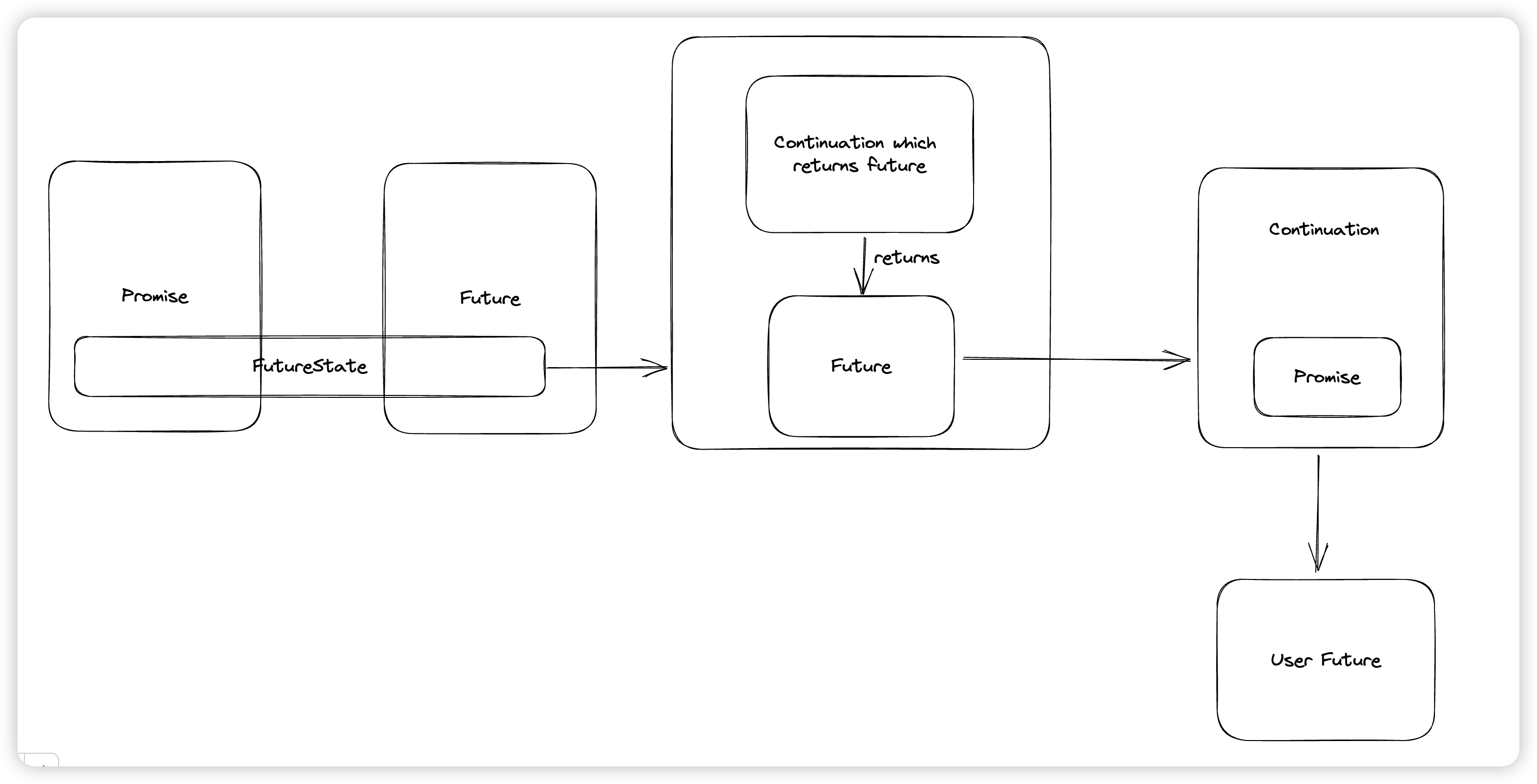async_simple Future/Promise 概览
简单看看async_simple的Future/Promise。注意这里不会关注coroutine/uthread部分
Future/Promise这块和folly,以及seastar的接口都是类似的,之后可以再写一下他们实现上的区别。
简单来说,就是Promise可以获取一个对应的Future,对应生产者和消费者。然后Future可以通过then(Func &&func)来创建一个continuation,表示在这个future获取到结果后,就会将future的结果传给continuation。这样在写代码的时候就可以通过then来将回调串起来,可读性就更强一些。
大概比对一下就是这样的
// callback
void A(ParamA pa, CallbackA cb);
void B(ParamB pb, CallbackB cb);
void C(ParamC pc);
A(pa, [](ParamB pb){ B(pb, [](ParamC pc) { C(pc)}); });
// future/promise/continuation
Future<ParamB> A(ParamA pa);
Future<ParamC> B(ParamB pb);
void C(ParamC pc);
A(pa).then([](ParamB pb) { return B(pb); }).then([](ParamC pc) { C(pc); })
所以其实只是不同的写法而已,如果写Callback流的作者对代码组织的比较好的话,也是可以达到类似的效果的,不过也要看这个自动机的复杂程度了。
这个库提供的主体就是Future/Promise,以及一些辅助的工具,比如Try,有点类似StatusOr<T>这样,然后还有Executor,表示设置Callback的执行位置。
比如可以这样写
A(pa).via(executorB).then([](ParamB pb) { return B(pb); }).via(executorC).then([](ParamC pc) { C(pc); })
这样可以让B执行在executorB上,让C执行在executorC上。
然后看一下实现
class Promise {
using value_type = std::conditional_t<std::is_void_v<T>, Unit, T>;
FutureState<value_type>* _sharedState = nullptr;
bool _hasFuture = false;
};
Promise的构造函数会构造一个FutureState,FutureState内部自己记录了自己的refcnt。
对于Void类型的Promise,async_simple搞了一个空的类型叫Unit。
Future<T> getFuture() {
logicAssert(valid(), "Promise is broken");
logicAssert(!_hasFuture, "Promise already has a future");
_hasFuture = true;
return Future<T>(_sharedState);
}
getFuture的作用就是将_hasFuture设为true,然后用FutureState初始化一个Future。这样这一对Future/Promise就通过_sharedState链接起来了。
void setValue(value_type&& v) requires(!std::is_void_v<T>) {
logicAssert(valid(), "Promise is broken");
_sharedState->setResult(Try<value_type>(std::forward<T>(v)));
}
Promise中的大多数操作都是直接操作的_sharedState,因为Promise的操作都是对Future有影响的,所以也就需要操作他们共享的FutureState
template <typename T>
class FutureState {
using Continuation = std::function<void(Try<T>&& value)>;
std::atomic<detail::State> _state;
std::atomic<uint8_t> _attached;
std::atomic<uint8_t> _continuationRef;
Try<T> _try_value;
union {
Continuation _continuation;
};
Executor* _executor;
Executor::Context _context;
std::atomic<std::size_t> _promiseRef;
bool _forceSched;
};
看一下FutureState,_attached,_continuationRef以及_promiseRef就是他的引用计数,引用计数到0的时候就会把自己析构掉。
_try_value就是这个Future的返回值。_executor是该Future的Continuation的执行器。_context是执行器相关的东西,不用太关注。
这里有个union的_continuation,其作用是不会主动的做构造,因为不是每个Future都有Continuation。
核心的函数主要有三个:
template <typename F>
void setContinuation(F&& func) {
logicAssert(!hasContinuation(),
"FutureState already has a continuation");
MoveWrapper<F> lambdaFunc(std::move(func));
new (&_continuation) Continuation([lambdaFunc](Try<T>&& v) mutable {
auto& lambda = lambdaFunc.get();
lambda(std::forward<Try<T>>(v));
});
auto state = _state.load(std::memory_order_acquire);
switch (state) {
case detail::State::START:
if (_state.compare_exchange_strong(
state, detail::State::ONLY_CONTINUATION,
std::memory_order_release)) {
return;
}
// state has already transferred, fallthrough
assert(_state.load(std::memory_order_relaxed) ==
detail::State::ONLY_RESULT);
case detail::State::ONLY_RESULT:
if (_state.compare_exchange_strong(state, detail::State::DONE,
std::memory_order_release)) {
scheduleContinuation(true);
return;
}
default:
logicAssert(false, "State Transfer Error");
}
}
在刚才提到的union上构造一个Continuation,然后去CAS当前state。这个state有四种状态,分别是START,ONLY_CONTINUATION,ONLY_RESULT,DONE。
如果当前为START,说明目前还没有SetValue,那么就直接返回。如果是ONLY_RESULT,说明目前已经SetValue了,那么就需要我们去手动触发Continuation的调度,所以这里调用了scheduleContinuation
void setResult(Try<T>&& value) {
_try_value = std::move(value);
auto state = _state.load(std::memory_order_acquire);
switch (state) {
case detail::State::START:
if (_state.compare_exchange_strong(state,
detail::State::ONLY_RESULT,
std::memory_order_release)) {
return;
}
// state has already transfered, fallthrough
assert(_state.load(std::memory_order_relaxed) ==
detail::State::ONLY_CONTINUATION);
case detail::State::ONLY_CONTINUATION:
if (_state.compare_exchange_strong(state, detail::State::DONE,
std::memory_order_release)) {
scheduleContinuation(false);
return;
}
default:
logicAssert(false, "State Transfer Error");
}
}
这里也是去CAS state,如果是先变成ONLY_RESULT,那么调度Continuation的责任就是调用setContinuation的人。如果已经设置了Continuation,那么setResult的人就要负责调用scheduleContinuation。
void scheduleContinuation(bool triggerByContinuation) {
logicAssert(
_state.load(std::memory_order_relaxed) == detail::State::DONE,
"FutureState is not DONE");
if (!_forceSched && (!_executor || triggerByContinuation ||
currentThreadInExecutor())) {
// execute inplace for better performance
ContinuationReference guard(this);
_continuation(std::move(_try_value));
} else {
ContinuationReference guard(this);
ContinuationReference guardForException(this);
try {
bool ret;
if (Executor::NULLCTX == _context) {
ret = _executor->schedule(
[fsRef = std::move(guard)]() mutable {
auto ref = std::move(fsRef);
auto fs = ref.getFutureState();
fs->_continuation(std::move(fs->_try_value));
});
} else {
ScheduleOptions opts;
opts.prompt = !_forceSched;
// schedule continuation in the same context before
// checkout()
ret = _executor->checkin(
[fsRef = std::move(guard)]() mutable {
auto ref = std::move(fsRef);
auto fs = ref.getFutureState();
fs->_continuation(std::move(fs->_try_value));
},
_context, opts);
}
if (!ret) {
throw std::runtime_error(
"schedule continuation in executor failed");
}
} catch (std::exception& e) {
// reschedule failed, execute inplace
_continuation(std::move(_try_value));
}
}
}
这里有一个选项,可以尝试原地执行Continuation。这里会避免在SetResult的时候做Inplace Execution,我怀疑可能是因为SetResult可能是在一些其他不受控制的Callback中,比如libaio,在里面做Inplace Execution会影响他的Callback线程。
然后就调_executor->schedule()来执行Continuation,这里会把FutureState引用住,然后调他的Continuation。
最后就是看一下Future的实现了。最简单的一个就是via(),就是会把Executor赋给刚才FutureState中的Executor,用来指定当前Future的Continuation的Executor是谁。
// continuation returns a future
template <typename F, typename R>
Future<typename R::ReturnsFuture::Inner> thenImpl(F&& func) {
logicAssert(valid(), "Future is broken");
using T2 = typename R::ReturnsFuture::Inner;
Promise<T2> promise;
auto newFuture = promise.getFuture();
newFuture.setExecutor(_sharedState->getExecutor());
_sharedState->setContinuation(
[p = std::move(promise),
f = std::forward<F>(func)](Try<T>&& t) mutable {
if (!R::isTry && t.hasError()) {
p.setException(t.getException());
} else {
if constexpr (R::ReturnsFuture::value) {
try {
auto f2 = f(std::move(t));
f2.setContinuation(
[pm = std::move(p)](Try<T2>&& t2) mutable {
pm.setValue(std::move(t2));
});
} catch (...) {
p.setException(std::current_exception());
}
} else {
p.setValue(makeTryCall(std::forward<F>(f),
std::move(t))); // Try<Unit>
}
}
});
return newFuture;
}
这里会先创建一对Future/Promise,然后将当前Future的Continuation设置为一个Lambda,然后返回新的Future。
这个Lambda会在当前Future的值被填充好后调用,他会得到当前Future的值,然后判断传入的Continuation的类型。如果下一个Continuation的返回值是普通的值(而非Future),那么他会填充刚才新创建的Promise,这样返回的Future就Ready了。
如果下一个Continuation的返回值是Future,我们就会先执行f,来得到这个新的Future,然后将这个新的Future的Continuation设置成给刚才的Promise填充值,这样当新的Future Ready之后,返回的Future也就Ready了。
对于Continuation的返回值是普通值的图示大概是这样:

而对于Continuation的返回值是Future的图示大概是这样

void wait() {
if (hasResult()) {
return;
}
// wait in the same executor may cause deadlock
assert(!currentThreadInExecutor());
// The state is a shared state
Promise<T> promise;
auto future = promise.getFuture();
_sharedState->setExecutor(
nullptr); // following continuation is simple, execute inplace
std::mutex mtx;
std::condition_variable cv;
std::atomic<bool> done{false};
_sharedState->setContinuation(
[&mtx, &cv, &done, p = std::move(promise)](Try<T>&& t) mutable {
std::unique_lock<std::mutex> lock(mtx);
p.setValue(std::move(t));
done.store(true, std::memory_order_relaxed);
cv.notify_one();
});
std::unique_lock<std::mutex> lock(mtx);
cv.wait(lock,
[&done]() { return done.load(std::memory_order_relaxed); });
*this = std::move(future);
assert(_sharedState->hasResult());
}
这里Wait的实现我个人感觉还挺巧妙的,就是将Continuation设置成对于CV的唤醒,然后让当前线程睡在CV上。感觉是一个对Continuation的灵活运用了。

连续的then调用的链路大概就是这样的,用户拿到的是最下面的future。
个人感觉这里和seastar实现的还是有点不同的,这里并没有做Promise/Future的Detach,而是通过一对新的Future/Promise,让这个嵌套的Future在Ready的时候可以填充新生成的Future/Promise。我感觉async_simple实现的更优雅些,不过seastar那个是单线程的,并且性能方面可能也有差异。
文章评论